How to Fix Commercial Roof Problems in 6 Steps
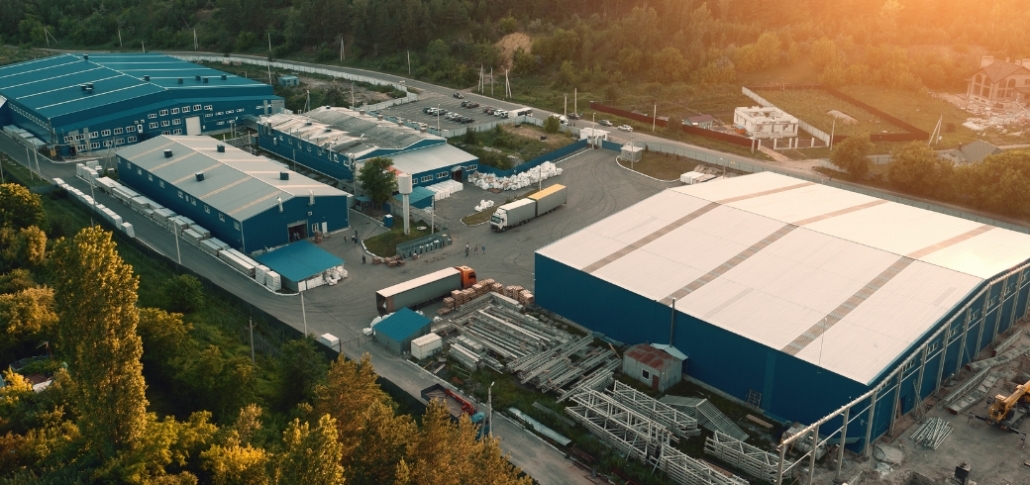
When your commercial building’s roof leaks or suffers damage, it can have serious consequences, including inventory damage and liability issues.
To fix commercial roof problems, you need to diagnose the issue, install temporary solutions, consider your options for materials and permanent fixes, and work with experienced professionals.
When deciding how to fix commercial roof problems, business owners and managers need to consider the business’s needs and long-term goals to ensure a solution that fits their situation.
An inexpensive fix may cost more money in the long run if it fails, leaving the business with a leaking or damaged roof.
Future weather events could lead to indoor leaks, damage to inventory or equipment, and potential liability if someone slips and falls.
Here are the 6 steps to fix commercial roof problems:
- Diagnose the Problem: Inspection and Leak Tracing
- Make the Roof Watertight Right Away: Temporary Fixes
- Permanent Repair Techniques by Roof Type
- Decide – Repair, Restore, or Replace
- Pick the Right Materials and Coating
- Work with Vetted Professionals and Maintain the Roof
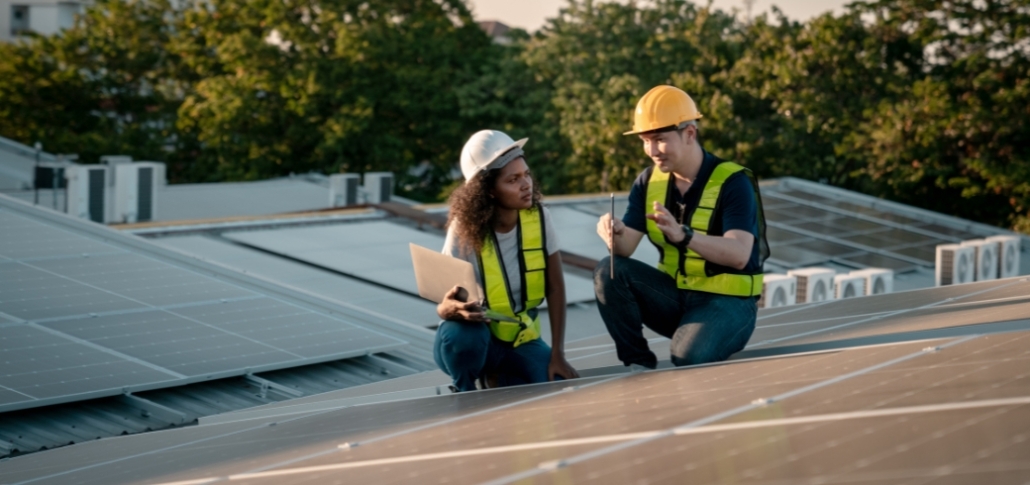
1. Diagnose the Problem: Inspection and Leak Tracing
The first step in diagnosing roof issues is to perform an exterior walk-through to look for signs of damage. These include membrane tears, punctures, ponding, corrosion, and loose flashings. Make note of any damage and take pictures in case they are needed for contractors or insurance adjusters.
Next, move on to an interior check. Look for water stains, mold, wet insulation, and ceiling bubbles. Again, note the signs and take photos for later use.
Not all roof leak signs are visible, so your next step should be to use moisture-scan tools such as infrared, core cuts, and capacitance meters. Sometimes, these tools may find additional problems you didn’t know about.
For instance, an infrared scanner can show areas where moisture is trapped in the roof, even when there are no visible leaks. This is because tiny leaks can cause uneven heat distribution, which is picked up by infrared.
Infrared scanners and other moisture-scanning tools are available at most hardware stores, but if you don’t want to invest in pricy equipment, you should contact a professional to check your roof. Commercial roof repair professionals have all the tools needed to identify roof damage and trace the leaks, so you know exactly what needs to be fixed.
When you’re done inspecting and tracing leaks, create a written report for the building owner, noting all the problems and including photos. If you are the building owner, this report will be helpful in filing an insurance or warranty claim.
Request A Free Quote
Speak To Our Roofing Specialists Today!
National Roofing & Solar offers expert commercial roof replacements, leak repairs, and solar upgrades, maximizing energy efficiency and ROI.
2. Make the Roof Watertight Right Away: Temporary Fixes
Preventing further damage should be the priority when your roof surface is damaged. It can take time to obtain estimates, gather materials, and schedule contractors. Meanwhile, every time it rains, your building could suffer damage, or a slippery floor could become a liability.
Here are some basic steps to take until you can complete permanent repairs:
- Place emergency tarping over open seams, cracks, or impact holes, or any other visible damage. You can buy emergency tarping at most hardware stores.
- Use sealant or mastic on small cracks or fastener heads.
- Deal with any water that’s already in the building. Pump or sweep off standing water, and remember to clear the drains and scuppers. Set out Wet Floor signs around any areas that remain damp.
- Set up safety zones and document all interim measures by taking photos.
- Keep an eye out for any interior leaks you didn’t notice previously so that you can address these. Ask your employees or coworkers to do the same.
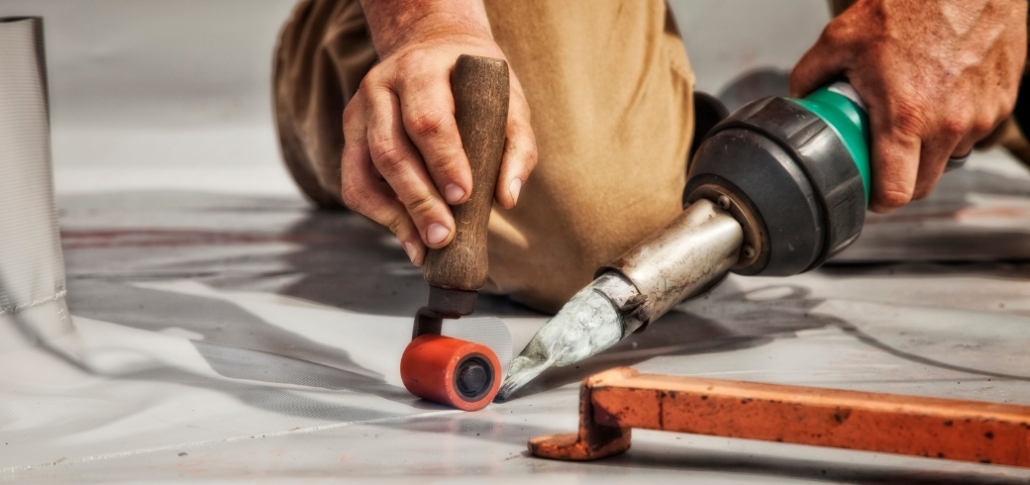
3. Permanent Repair Techniques by Roof Type
Next, you’ll need to decide on a repair technique, which can vary depending on the type of roof you have. Here are some of the most common options by roof type:
- Single-ply (TPO, EPDM, PVC): You can clean, prime, and heat-weld a patch or glue down an EPDM cover strip.
- Built-up/modified bitumen: Cut damaged felts, install a new ply sheet, or embed a gravel-surfaced flood coat.
- Metal roofs: Replace loose screws on the metal roof, add butyl tape under panel laps, or reinforce seams with cover-boards.
- Flat roofs or low-slope restorations: Install a fluid-applied coating system after repairs to extend service life.
4. Decide: Repair, Restore, or Replace
Should you repair or replace your roof? This is a common concern after roof damage. Many business owners or managers aren’t sure what will be the most effective approach or what will be more cost-efficient in the long run.
Here are some factors you should consider when deciding how to proceed:
Industry Benchmarks
It’s important to think about the water entry points and the wet insulation area. If there are multiple entry points and a large area of damp insulation, repairs may be almost as expensive as a full replacement. In this case, a complete replacement might be preferable.
The age of your roof is also a concern. A typical lifespan for a commercial roof is 20 to 30 years, so if it’s approaching the 30-year mark, it may be time for a full replacement anyway. Putting money into repairs on an older roof may not be worthwhile, and in some cases, the roof may not withstand repairs.
You also have to consider the roof’s warranty status and what the warranty covers. Some warranties may only cover a full roof replacement after a certain number of repairs, or when the warranty company approves it.
Additionally, your business insurance might cover some roof damage, depending on the situation, your deductible, and the cause of the damage. If it is covered, the insurance company could pay for repairs, but not a replacement in some situations. You should begin a claim as soon as you notice damage to your roof surface, so you can find out what the insurer will or won’t cover.
When you are renting your commercial building, you may need to check your lease contract to determine who is responsible for roof repair or replacement and in what circumstances.

Cost Tiers
The expense difference of replacing a roof versus making different types of repairs to existing roofing can be staggering. Spot repairs are typically cheaper than a partial tear-off with overlay, but may not hold up as well. In some cases, you could find that your roof is leaking again in a few months with a spot repair.
A partial tear-off will usually last longer than a spot repair, and is less expensive than a full roof repair. Again, if you have multiple entry points, performing multiple partial tear-offs may not be as cost-effective as a new roof.
Long-Term Plans
Considering your future business plans is also essential. Do you intend to keep using the building, or have you considered moving to another location in the future? If you plan to end your lease or sell in a few years, you might not want to put money into a complete replacement. (However, if you own the building and plan to sell it, a full replacement could increase its resale value.)
If you are planning to remain in the building for years to come, do you have future goals that might affect the roof? Adding solar panels or other equipment, for example, can add weight to the roof, putting further strain on repaired areas. In that case, investing in a new, strong roof would be a good idea.
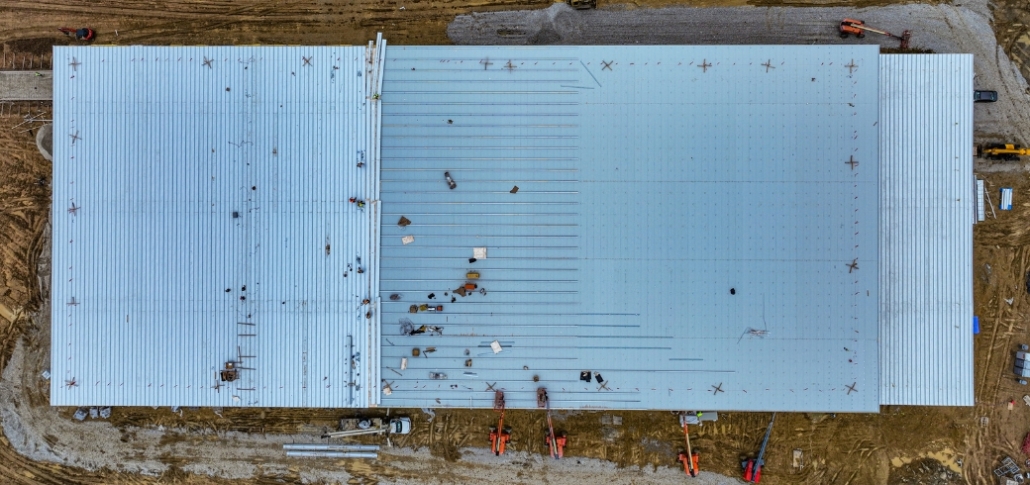
5. Pick the Right Materials and Coating
Once you’ve decided on a course of action, you’ll need to decide on the specifics of your roof repair or replacement.
Here are some helpful tips to keep in mind when choosing roofing materials and coatings:
- Matching materials: If you’re going with a repair, you’ll need to choose consistent materials, colors, and patterns. Selecting materials that look significantly different can not only be aesthetically displeasing, but it can also decrease the building’s value. In some cases, if the same material is no longer available, an insurance or warranty company may pay for a full replacement.
- Choosing materials for a replacement: If you’re replacing the whole roof, you have a wider array of options. It’s important to consider your location, the stresses your roof will be subjected to, and how different types of materials interact with these factors.
- Roof coating types: Silicone is ideal for ponding, while acrylic is suitable for reflectivity and ideal in hotter climates. Meanwhile, polyurethane is recommended for foot-traffic zones on an industrial roof. Your roofing contractor can explain the different solutions to extend the life of your roof.
- Local climate: You should take regional weather and climate into consideration, including UV intensity and your goals for heating/cooling the building. Metal roofs, for example, have high reflectivity and may be helpful in high-UV intensity areas. However, you also have to consider New England winters, which bring snow, ice, and other harsh weather. Choosing materials that can stand up to these elements is essential.
- Maintenance requirements: Some materials, like metal and Duro-Last roofing, require minimal maintenance, while others, like EPDM and modified bitumen, will necessitate regular inspections and repairs. If you want to avoid future expenses and stress around maintenance, your roofing contractor can review the lower-maintenance options with you.
- Aesthetic factors. Some businesses, such as shopping plazas, need a more aesthetically pleasing roof, and business owners may find that Duro-Last custom-fabricated roofing is a good option.
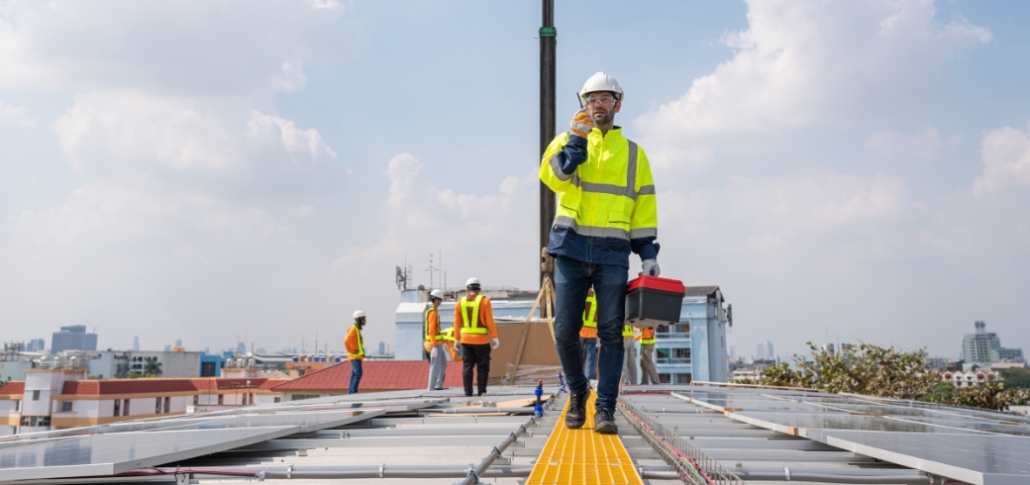
6. Work with Vetted Professionals and Maintain the Roof
A good contractor can help your roof repair or replacement go smoothly, and they may even be able to save you some money. On the other hand, a bad contractor can cost you both time and money, so it’s essential to choose carefully. Here are some ways to choose the best professionals for the job:
- Ask potential contractors about their licensing and check with the state licensing board to confirm they are in good standing.
- After confirming licensing, ask the contractor to see proof of their Workers’ Compensation insurance. If an injured worker isn’t covered by Workers’ Compensation insurance, they might pursue a lawsuit against the property owner.
- Inquire about manufacturer certifications and warranties when choosing materials. You will want to know how long you can expect materials to hold up, and steps to take to extend their life.
- Research the contractor’s safety record and check their references. You can also ask for examples of local completed projects so you know what their finished work looks like.
- Read online reviews about the company.
- Confirm that the materials manufacturer’s repair specs will be followed so you can protect your warranty status.
Once your roof is repaired or replaced, you’ll want to keep it in good shape for as long as possible. Schedule bi-annual inspections as well as a checkup after any significant storm or weather event. These regular roof inspections can help you identify and fix small problems early, so they don’t turn into bigger issues. A digital maintenance log can also help you stay on track with inspections.
Request A Free Quote
Speak To Our Roofing Specialists Today!
National Roofing & Solar offers expert commercial roof replacements, leak repairs, and solar upgrades, maximizing energy efficiency and ROI.
FAQs
The cost to repair a commercial roof depends on several factors, including the type of roof (flat, metal, EPDM, TPO, etc.), the extent of the damage, and the location. Typically, repairs for a commercial roof can range from $500 to $5,000.
A commercial roof typically needs to be replaced every 20 to 30 years, depending on the type of roofing material used. For instance:
1. EPDM and TPO roofs may last about 20 years.
2. Metal roofs often last 30+ years.
Regular maintenance and inspections can help extend the lifespan of the roof and prevent premature replacement.
The life expectancy of a commercial roof varies by the material:
1. TPO and EPDM roofing: 20 to 25 years
2. Metal roofing: 30 to 50 years
3. Modified Bitumen: 20 to 30 years
4. Built-up roofing (BUR): 20 to 30 years
Roofing systems that are well-maintained and properly installed can often last longer than their typical lifespan, especially with periodic inspections and repairs.
Conclusion
Dealing with a damaged commercial roof can be time-consuming and expensive for business professionals, but planning carefully with regard to materials and types of repairs or replacement can reduce difficulties in the future.
While it may be tempting to try to fix the issue yourself or hire the least expensive contractor available, having your commercial roof fixed by professionals is essential.
Long-term, you will spend far more money and time fixing a poorly done repair or replacement than you would investing in quality work from the start.
If you’re ready to learn more about how to fix commercial roof problems or get a repair or replacement estimate, contact National Roofing & Solar Corporation for a free quote.
Our roofing system specialists will diagnose the problem, outline your options, and assist you with every step of repairing or replacing your roof.


